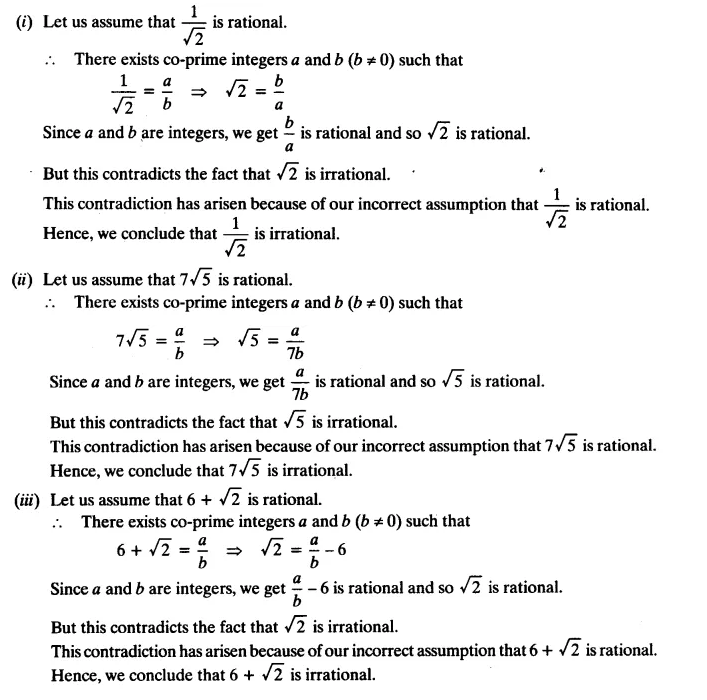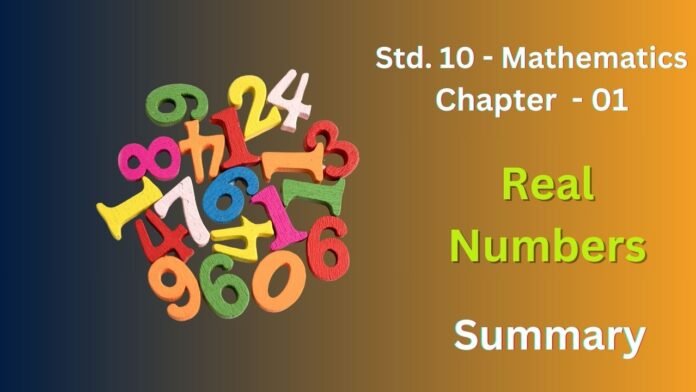Real Numbers is the first chapter in the NCERT Maths textbook for Class 10. It lays the foundation for understanding the number system in depth.
Key Concepts
- Euclid’s Division Lemma: This lemma states that given two positive integers ‘a’ and ‘b’, there exist unique integers ‘q’ and ‘r’ such that a = bq + r, where 0 ≤ r < b. This is the basis for finding the HCF of two numbers.
- Euclid’s Division Algorithm: A step-by-step process to find the HCF of two positive integers based on Euclid’s Division Lemma.
- Fundamental Theorem of Arithmetic: Every composite number can be expressed as a product of its prime factors, and this factorization is unique, apart from the order in which the factors occur.
- Prime Factorization: Expressing a number as a product of its prime factors.
- HCF and LCM: Finding the highest common factor (HCF) and lowest common multiple (LCM) of numbers using prime factorization.
- Rational and Irrational Numbers: Understanding the difference between terminating and non-terminating recurring decimals. Rational numbers can be expressed as p/q, where p and q are integers and q ≠ 0. Irrational numbers cannot be expressed in this form.
- Real Numbers: The combination of rational and irrational numbers forms the set of real numbers.
- Decimal Expansions: Exploring the decimal expansions of rational and irrational numbers.
Important Points
- The decimal expansion of a rational number is either terminating or recurring.
- The decimal expansion of an irrational number is non-terminating and non-recurring.
- The sum, difference, product, and quotient of a rational and an irrational number is irrational.
- The square root of a prime number is irrational.
Exercise 10.1
1. Express each number as a product of its prime factors:
(i) 140
(ii) 156
(iii) 3825
(iv) 5005
(v) 7429
Ans :
(i) 140
- 140 = 2 × 70
- 70 = 2 × 35
- 35 = 5 × 7
- So, 140 = 2 × 2 × 5 × 7 = 2² × 5 × 7
(ii) 156
- 156 = 2 × 78
- 78 = 2 × 39
- 39 = 3 × 13
- So, 156 = 2 × 2 × 3 × 13 = 2² × 3 × 13
(iii) 3825
- 3825 = 3 × 1275
- 1275 = 3 × 425
- 425 = 5 × 85
- 85 = 5 × 17
- So, 3825 = 3 × 3 × 5 × 5 × 17 = 3² × 5² × 17
(iv) 5005
- 5005 = 5 × 1001
- 1001 = 7 × 143
- 143 = 11 × 13
- So, 5005 = 5 × 7 × 11 × 13
(v) 7429
- 7429 is a prime number itself.
- So, 7429 = 7429
2. Find the LCM and HCF of the following pairs of integers and verify that LCM x HCF = Product of the two numbers:
(i) 26 and 91
(ii) 510 and 92
(iii) 336 and 54
Ans :
(i) 26 and 91
Prime factorization of 26 = 2 × 13
Prime factorization of 91 = 7 × 13
HCF = 13
LCM = 2 × 7 × 13
= 182
Verification:
LCM × HCF = 182 × 13
= 2366
Product of numbers = 26 × 91
= 2366
(ii) 510 and 92
Prime factorization of 510 = 2 × 3 × 5 × 17
Prime factorization of 92 = 2 × 2 × 23
HCF = 2
LCM
= 2 × 2 × 3 × 5 × 17 × 23
= 23460
Verification:
LCM × HCF
= 23460 × 2 =
46920
Product of numbers
= 510 × 92
= 46920
(iii) 336 and 54
Prime factorization of 336
= 2 × 2 × 2 × 2 × 3 × 7
Prime factorization of
54 = 2 × 3 × 3 × 3
HCF = 2 × 3 = 6
LCM
= 2 × 2 × 2 × 2 × 3 × 3 × 3 × 7
= 3024
Verification:
LCM × HCF
= 3024 × 6
= 18144
Product of numbers = 336 × 54 = 18144
In all three cases, we have verified that LCM × HCF = Product of the two numbers.
3. Find the LCM and HCF of the following integers by applying the prime factorization method:
(i) 12, 15 and 21
(ii) 17, 23 and 29
(iii) 8, 9 and 25
Ans :
(i) 12, 15, and 21
Prime factorization of 12
= 2 × 2 × 3
Prime factorization of 15
= 3 × 5
Prime factorization of 21
= 3 × 7
HCF: The highest common factor is the product of the common prime factors with the lowest powers.
HCF = 3
LCM: The lowest common multiple is the product of all prime factors with their highest powers.
LCM
= 2 × 2 × 3 × 5 × 7
= 420
(ii) 17, 23, and 29
Prime factorization of 17 = 17
Prime factorization of 23 = 23
Prime factorization of 29 = 29
Since there are no common prime factors,
the HCF is 1.
All numbers are prime, so the LCM is their product.
HCF = 1
LCM = 17 × 23 × 29
= 11339
(iii) 8, 9, and 25
Prime factorization of 8 = 2 × 2 × 2
Prime factorization of 9 =
3 × 3
Prime factorization of 25
= 5 × 5
There are no common prime factors, so the HCF is 1.
HCF = 1
LCM = 2 × 2 × 2 × 3 × 3 × 5 × 5
= 1800
4. Given that HCF (306, 657) = 9, find LCM (306, 657).
Ans :
LCM(306,657)=306⋅657 / HCF(306,657)
LCM(306,657)=22338
The LCM is 22338.
5. Check whether 6n can end with the digit 0 for any natural number n.
Ans :
6. Explain why 7 x 11 x 13 + 13 and 7 x 6 x 5 x 4 x 3 x 2 x 1 + 5 are composite numbers.
Ans :
Expression 1: 7 x 11 x 13 + 13
- 13(7 x 11 + 1) = 13 * 78
- Clearly, 13 * 78 is a product of two numbers greater than 1 (13 and 78).
- Therefore, 7 x 11 x 13 + 13 is a composite number.
Expression 2: 7 x 6 x 5 x 4 x 3 x 2 x 1 + 5
- We can factor out 5 from both terms:
- 5(7 x 6 x 4 x 3 x 2 x 1 + 1) = 5 * 1009
- Again, 5 * 1009 is a product of two numbers greater than 1 (5 and 1009).
- Therefore, 7 x 6 x 5 x 4 x 3 x 2 x 1 + 5 is a composite number.
7. There is a circular path around a sports field. Sonia takes 18 minutes to drive one round of the field, while Ravi takes 12 minutes for the same. Suppose they both start at the same point and at the same time and go in the same direction. After how many minutes will they meet again at the starting point?
Ans :
Finding the LCM
- Prime factorization of 18 = 2 * 3 * 3
- Prime factorization of 12 = 2 * 2 * 3
LCM = 2 * 2 * 3 * 3 = 36
Therefore, Sonia and Ravi will meet again at the starting point after 36 minutes.
Exercise 1.2
1. Prove that √5 is irrational.
Ans :
2. Show that 3 + √5 is irrational.
Ans :
3. Prove that the following are irrational.
Ans :



